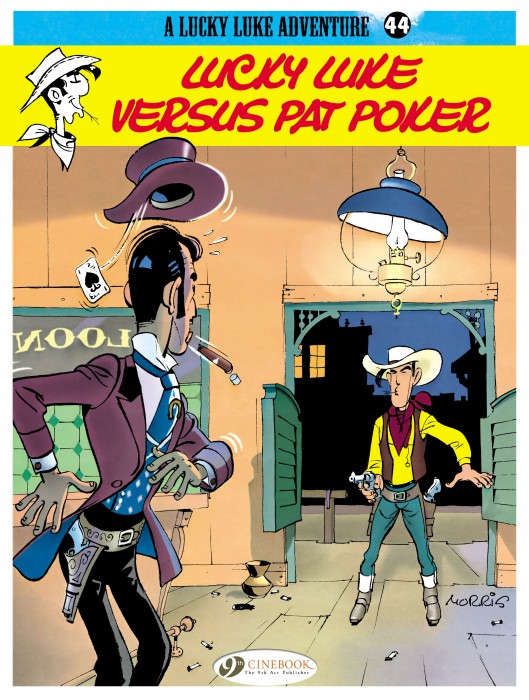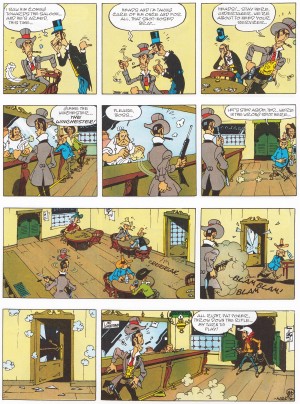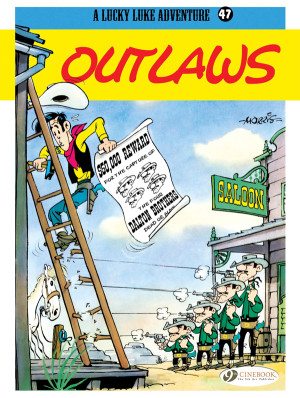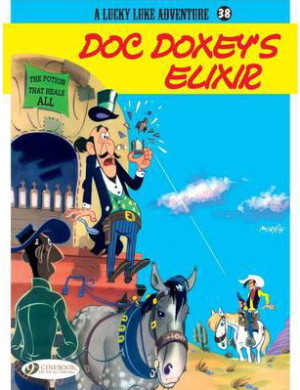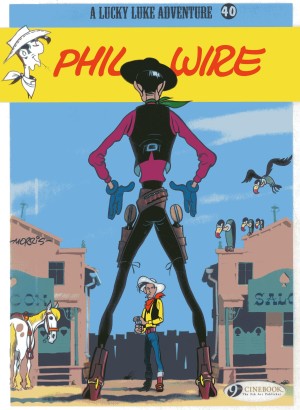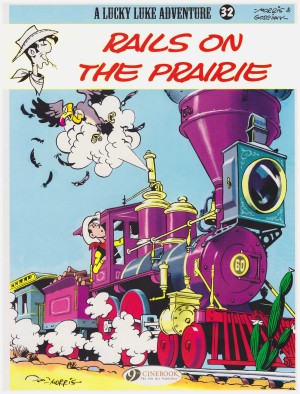Review by Jamie McNeil
Lucky Versus Pat Poker is a collection of two stories that present one of Lucky Luke’s earliest adversaries, the gambling man and scoundrel Pat Poker. Originally illustrated in children’s almanac Spirou, they were collected by Morris’ first publishers Dupuis in 1953 as the double titled Lucky Luke contre Pat Poker/Tumulte á Tumbleweed. Neither story was translated into English until Cinebook’s publication in 2013.
‘Clean-Up in Red-City’ sees Luke hired as sheriff for said town where Pat Poker and his gang run the place from the Silver Dollar Saloon and Casino. An encounter that isn’t entirely unrelated with happenings in Red City leaves Luke down on his luck before he gets there, so when he arrives in a borrowed schoolboy outfit Pat and his henchman severely underestimate our lonesome cowboy, leading to some stereotypical displays of male machismo.
‘Rough and Tumble in Tumbleweed’ has a similar premise, Luke drifting into a town run by a gunslinger called Angelface. When Pat Poker arrives he panics at the thought of a reunion with Luke but quickly finds an ally in Angelface. You’d think he learnt from their earlier encounter but once again Pat severely underestimates Lucky Luke.
Compare this to Morris’s earlier work in Arizona or Under a Western Sky and you are likely to notice that Luke and co are morphing into their familiar forms, the characters and ideas progressing and developing. It’s still far from the cool and collected Lucky Luke we know now, closer to the round and lumpier edges of animated shows (Morris’s gig prior to Lucky Luke), but quite an interesting study of how far the character has developed artistically under Morris and his successor Achde. Luke has a baby face complexion, curiously employs his fists and revolver more than he does his trademark wit, though that characteristic is percolating here. Similarly his trusty steed Jolly Jumper lacks those expressive features and knowing wink he employs to break the fourth wall and conspire with the reader, the eyes just black dots.
Morris’ writing relies heavily on the macho clichés of what masculinity should be like, the influences of the post war cinema shining through, with the cowboy stereotypes of Hollywood very much in evidence. The gags are situational and slapstick, the first few pages humorous in a way typical of the era but not particularly funny today. It has definitely aged but there are some interesting aspects. Morris is starting to show his trend for research into western history, in this case beliefs people had about sheep and cattle and why being called a shepherd was an insult. Compared to his work with Goscinny, the artwork is rather flat and functional with little flair but Morris’s skill as a cartoonist does shine through in movements and action sequences which carry an enjoyable energy. The plot is clunky and has gaping holes in places but there is a sense that something good is developing that can’t quite be seen yet, the old style Western fun comforting in an odd sort of way
Chronologically Outlaws was published next, both also found in volume two of Lucky Luke: The Complete Collection, but having delayed Pat Poker for so long, Cinebook’s next graphic novel was the more recent Tying the Knot.
